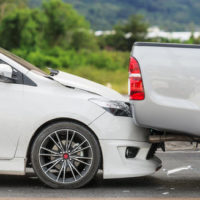
A rear-end accident is a type of traffic collision in which one car crashes into the car in front of it. Rear-end accidents are extremely common, in fact The Washington Post reports that there are approximately 1.7 million rear-end collisions in the United States each year. When this happens the rear driver is usually, but not always, legally at fault for causing the accident. This article briefly describes how car accident liability is determined in Florida and then provides examples of rear-end accidents in which the lead driver is actually the one commonly held liable.
Determining Fault After a Car Accident in Florida
Generally speaking, the rear driver in a rear-end collision is assumed to be at fault for causing the accident because that driver had a responsibility to leave sufficient room between his own car and the car in front of him so that he would be able to avoid a rear-end collision. In other words, every driver has a duty to follow other vehicles at a safe distance, and drivers who cause a rear-end collision because they failed to do so can be held liable for the accident. However, if the rear driver can show that the lead driver’s negligence caused, or contributed to the accident, then the presumption that the rear driver is solely at fault can be rebutted in Florida.
In Florida we embrace a pure comparative theory of fault under Florida Statutes section 768.81. This means that when an accident occurs responsibility and damages are based on each involved party’s percentage of fault. This means that a driver whose negligence partially caused an accident can still recover damages but these damages will be limited by that driver’s percentage of fault. For example, consider the following hypothetical situation: Car A slammed on their brakes unexpectedly to avoid hitting a cat in the road, Car B rear-ended Car A, and at the time of the accident the lead car’s brake lights were broken and the rear car was speeding. If a Florida court determines that Car A is 40 percent at fault and that Car B is 60 percent at fault, then Car A’s driver will be able entitled to recover their damages less 40 percent, and Car B’s driver will be able to recover their damages less 60 percent.
Examples of Rear-End Accidents where the Lead Driver is Commonly Held Liable
Under the circumstances listed below the lead driver in a rear-end accident is often found to be at least partially, if not fully, liable for the accident:
- The lead driver suddenly reverses,
- The lead driver makes a turn without properly using their turn signals,
- The lead driver has malfunctioning or broken tail lights,
- The lead driver slams on his or her brakes unexpectedly,
- The lead driver makes an erratic maneuver, or
- The lead driver pulls over to the side of the road and does not engage their vehicle’s hazard lights.
Need Legal Advice?
Determining liability after a rear-end accident can be complicated. Therefore, it is important to have an experienced auto, truck, and motorcycle accident lawyer by your side fighting for your rights and properly presenting your case. Here at Piccin & Glynn Lawyers at Law our personal injury lawyers are committed to providing exceptional legal counsel to each and every one of our clients and would be happy to assist you. To discuss your legal options during a free initial consultation contact our Ocala office today at 352-558-8480.
Resource:
washingtonpost.com/news/dr-gridlock/wp/2015/06/08/there-are-about-1-7-million-rear-end-collisions-on-u-s-roads-each-year-heres-how-to-stop-them/?utm_term=.219577f7e4b5

